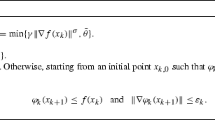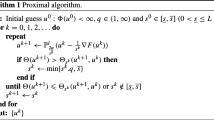Abstract
We devise a new generalized univariate Newton method for solving nonlinear equations, motivated by Bregman distances and proximal regularization of optimization problems. We prove quadratic convergence of the new method, a special instance of which is the classical Newton method. We illustrate the possible benefits of the new method over the classical Newton method by means of test problems involving the Lambert W function, Kullback–Leibler distance, and a polynomial. These test problems provide insight as to which instance of the generalized method could be chosen for a given nonlinear equation. Finally, we derive a closed-form expression for the asymptotic error constant of the generalized method and make further comparisons involving this constant.



Similar content being viewed by others
References
Aragón-Artacho, F.J., Dontchev, A.L., Gaydu, M., Geoffroy, M.H., Veliov, V.M.: Metric regularity of Newton’s iteration. SIAM J. Control Optim. 49, 339–362 (2011)
Diniz-Ehrhardt, M.A., Gomes-Ruggiero, M.A., Lopes, V.L.R., Martínez, J.M.: Discrete Newton’s method with local variations for solving large-scale nonlinear systems. Optimization 52, 417–440 (2003)
Dontchev, A.L., Hager, W.W., Veliov, V.M.: Uniform convergence and mesh independence of Newton’s method for discretized variational problems. SIAM J. Control Optim. 39, 961–980 (2000)
Ford, W.F., Pennline, J.A.: Accelerated convergence in Newton’s method. SIAM Rev. 38, 658–659 (1996)
Hoheisel, T., Kanzow, C., Mordukhovich, B.S., Phan, H.: Generalized Newton’s method based on graphical derivatives. Nonlinear Anal. 75, 1324–1340 (2012)
Kelley, C.T.: Solving Nonlinear Equations with Newton’s Method. SIAM, Philadelphia (2003)
Martínez, J.M.: Fixed-point quasi-Newton methods. SIAM J. Numer. Anal. 29, 1413–1434 (1992)
Martínez, J.M.: Practical quasi-Newton methods for solving nonlinear systems. J. Comput. Appl. Math. 124, 97–122 (2000)
Ortega, J.M., Rheinboldt, W.C.: Iterative Solution of Nonlinear Equations in Several Variables. Academic Press, New York (1970)
Polyak, B.T.: Newton’s method and its use in optimization. Eur. J. Oper. Res. 181, 1086–1096 (2007)
Qi, L., Sun, J.: A nonsmooth version of Newton’s method. Math. Program. 58, 353–367 (1993)
Thorlund-Petersen, L.: Global convergence of Newton’s method on an interval. Math. Methods Oper. Res. 59, 91–110 (2004)
Tseng, C.-L.: A Newton-type univariate optimization algorithm for locating the nearest extremum. Eur. J. Oper. Res. 105, 236–246 (1998)
Burachik, R.S., Iusem, A.N.: A generalized proximal point algorithm for the variational inequality problem in a Hilbert space. SIAM J. Optim. 8, 197–216 (1998)
Butnariu, D., Kassay, G.: A proximal-projection method for finding zeroes of set-valued operators. SIAM J. Control Optim. 47, 2096–2136 (2008)
Chen, G., Teboulle, M.: Convergence analysis of a proximal-like minimization algorithm using Bergman functions. SIAM J. Optim. 3, 538–543 (1993)
Burachik, R.S., Iusem, A.N.: Set-Valued Mappings and Enlargements of Monotone Operators. Optimization and Its Applications, vol. 8. Springer, New York (2008)
Burden, R.L., Faires, J.D.: Numerical Analysis, 9th edn. Thompson Brooks/Cole, Belmont (2011)
Bregman, L.: The relaxation method of finding the common points of convex sets and its application to the solution of problems in convex programming. U.S.S.R. Comput. Math. Math. Phys. 7, 200–217 (1967)
Rockafellar, R.T.: Convex Analysis. Princeton Univ. Press, Princeton (1970)
Dennis, J.E. Jr., Schnabel, R.B.: Numerical Methods for Unconstrained Optimization and Nonlinear Equations. Prentice Hall, Englewood Cliffs (1983)
Corless, R.M., Hare, D.E.G., Jeffrey, D.J., Knuth, D.E.: On the Lambert W function. Adv. Comput. Math. 5, 329–359 (1996)
Belen, S., Kaya, C.Y., Pearce, C.E.M.: Impulsive control of rumours with two broadcasts. ANZIAM J. 46, 379–391 (2005)
Ferreira, O.P., Svaiter, B.F.: Kantorovich’s majorants principle for Newton’s method. Comput. Optim. Appl. 42, 213–229 (2009)
Acknowledgements
Authors would like to thank Gábor Kassay for motivating discussions on antiresolvents of proximal-projection methods during his visit to the School of Mathematics and Statistics at the University of South Australia. The iteration formula (15) in Lemma 4.1 is an interpretation of Roberto Cominetti after seeing our generalized Newton iteration formula in (3). The authors are indebted to him for his observation, which consequently made the proof of Theorem 4.1 neater. They also thank the referees, whose comments and suggestions improved the paper.
Author information
Authors and Affiliations
Corresponding author
Additional information
Communicated by Liqun Qi.
Rights and permissions
About this article
Cite this article
Burachik, R.S., Kaya, C.Y. & Sabach, S. A Generalized Univariate Newton Method Motivated by Proximal Regularization. J Optim Theory Appl 155, 923–940 (2012). https://doi.org/10.1007/s10957-012-0095-5
Received:
Accepted:
Published:
Issue Date:
DOI: https://doi.org/10.1007/s10957-012-0095-5




